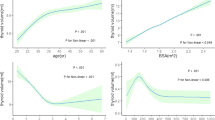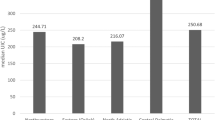Abstract
Purpose
North Macedonia is historically iodine deficient, but due to the longstanding and effective preventive measures, it has been considered iodine replete since 2003. The aim of the recent national survey was to re-evaluate iodine status and to measure thyroid volume (TVol) by ultrasound in schoolchildren as a representative of the general population.
Methods
A stratified probability proportionate to size cluster sampling was used to obtain a representative national sample of school children aged 7–10 years between the 28th of March and 4th of October 2016. Thyroid volume (TVol) was measured using ultrasonography in 1188 children. All TVol measurements were done by a single operator and their medians were compared with an international reference standard.
Results
Significant positive correlation was found between Tvol and age, height, weight, body surface area (BSA), body mass index (BMI) in both girls and boys (p < 0.001), but not between TVol and urinary ioidine concentration (UIC). The most important predictors for Tvol in all children were age, height, weight, BMI, and BSA ( all p < 0.001). In multivariate regression, independent predictors for TVol were only BSA (p < 0.001) and age (p = 0.004) after being adjusted for sex, BMI, and UIC (R2 = 0.291). The 97th percentile of Tvol in our survey was generally higher than in the reference study and goiter prevalence of 18.3% in boys and 15.6% in girls was found compared to the international standard.
Conclusion
In our survey, Tvol of schoolchildren was larger than in the international reference study, although iodine nutritional status of the country has been considered sufficient for many years. In countries and regions with long and effective, well-documented iodine prophylaxis, the optimal way to have realistic normative TVol would be to create their TVol reference limits. Therefore, the provided data for TVol measured in our survey could be proposed as the national reference TVol for schoolchildren aged 7–10 years.


Similar content being viewed by others
References
Petrov S (1955) Goiter in the People's Republic of Macedonia. Hig Cas Hig Mikrobiol Epidemiol Sanit Teh 7(1–4):322–328
Ramzin S (1959) Značaj endemske strume, problemi epidemiologije i etiologije kod nas. In: Zbornik radova prvog Jugoslovenskog simpozijuma o gušavosti. Conference proceedings (serb.), Beograd, pp 27–60
Vandeska M, Dolgova-Korubin V, Tadzer I (1980) Reziduum endemske strume u SRM. In: Četvrti Jugoslovenski simpozijum o štitastoj žlezdi. Conference proceedings (serb.) Zlatibor, pp 361–363
Karanfilski B, Bogdanova V, Vaskova O et al (1998) Iodine deficiency in the FY Republic of Macedonia (conditions, consequences and opportunities for prevention). Monograph, Skopje, UNICEF
Karanfilski B, Bogdanova V, Vaskova O et al (2004) The correction of iodine deficiency in Macedonia. Monograph, National Committee for Iodine Deficiency, Skopje, UNICEF Office
External Review of Progress in Republic of Macedonia Towards Sustainable Optimal Iodine Nutrition, Report by the Team of Experts nominated by the Network for Sustained Elimination of Iodine Deficiency (2003) Skopje, WHO/UNICEF/ICCIDD
WHO, UNICEF, ICCIDD (2007) Assessment of iodine deficiency disorders and monitoring their elimination. World Health Organisation, ISBN 978 92 4 159582 7
W. E. Committee (1995) Physical status: the use and interpretation of anthropometry. In: WHO Technical Report Series vol 854, no 121, p 55
Dubois D, Dubois E (1916) A formula to estimate the approximate surface area if height and weight be known. Arch Intern Med 17:863–871
Brunn J, Block U, Ruf G, Bos I, Kunze WP, Scriba PC (1981) Volumetric analysis of thyroid lobes by real-time ultrasound (author's transl). Dtsch Med Wochenschr 106:1338–1340
Sullivan KM, May S, Maberly G (2000) Urinary iodine assessment: a manual on survey and laboratory methods, 2nd edn. UNICEF, PAMM
Caldwell KL, Maxwell CB, Makhmudov A et al (2003) Use of inductively coupled plasma mass spectrometry to measure urinary iodine in NHANES 2000: comparison with previous method. Clin Chem 49:1019–1021
Delange F, Benker G, Caron P et al (1997) Thyroid volume and urinary iodine in European schoolchildren: standardization of values for assessment of iodine deficiency. Eur J Endocrinol 136:180–187
Zimmermann MB, Hess SY, Molinari L et al (2004) New reference values for thyroid volume by ultrasound in iodine-sufficient schoolchildren: a World Health Organization/Nutrition for Health and Development Iodine Deficiency Study Group Report. Am J Clin Nutr 79:231–237
WHO (2003) Vitamin and Mineral Information System. Urinary iodine concentrations for determining iodine status in populations. WHO/NMH/NHD/EPG 13.1. https://www.who.int/vmnis/indicators/urinaryiodine/en/
Loparska S (2004) Measurement of thyroid volume with ultrasonography. The correction of iodine deficiency in fyr Macedonia. Monograph, National committee for iodine deficiency, Skopje, UNICEF Office
Karanfilski B, Milevska-Kostova N, Miladinova D, Jovanovska V, Kochova M (2018) Continued efforts are key to sustaning ioidine sufficiency in Macedonia. IDD Newsl 46(4):12–13
WHO, UNICEF, ICCIDD (2000) Standardization of ultrasound and urinary iodine determination for assessing iodine status: report of a technical consultation. IDD Newsl 16(2):19–23
Andermann P, Schlogl S, Mader U, Luster M, Lassmann M, Reiners C (2007) Intra- and interobserver variability of thyroid volume measurements in healthy adults by 2D versus 3D ultrasound. Nuklearmedizin 46:1–7
Mo Z, Lou X, Mao G et al (2016) Larger thyroid volume and adequate iodine nutrition in chinese schoolchildren: local normative reference values compared with WHO/IGN. Int J Endocrinol 2016:8079704
Szybinski Z, Trofimiuk-Muldner M, Buziak-Bereza M, Walczycka L, Hubalewska-Dydejczyk A (2012) Reference values for thyroid volume established by ultrasound in Polish schoolchildren. Endokrynol Pol 63:104–109
Kalantari S, Moghadam MV (2015) Thyroid gland volume of schoolchildren in the North of Iran: comparison with other studies. J Res Med Sci 20:1070–1076
García-Ascaso MT, Ares Segura S, Ros Pérez P, Piñeiro Pérez R, Alfageme Zubillaga M (2019) Thyroid volume assessment in 3–14 year-old Spanish children from an iodine-replete area. Eur Thyroid J 8:196–201
Funding
This work was supported by the EUthyroid project, financially supported by funding from the European Union’s Horizon 2020 research and innovation programme under Grant agreement no. 634453.
Author information
Authors and Affiliations
Corresponding author
Ethics declarations
Conflict of interest
The authors declare that they have no conflict of interest.
Ethical approval
All procedures performed in studies involving human participants were in accordance with the ethical standards of the institutional and/or national research committee (the study protocol was approved by the Ministry of Health, Ministry of Education and Science and Ethics Committee of Faculty of Medicine in Skopje, Ss. Cyril and Methodius University Skopje) and with the 1964 Helsinki declaration and its later amendments or comparable ethical standards.
Informed consent
Parents were informed about the study and written informed consent was obtained to allow participation of the children in the examination.
Additional information
Publisher's Note
Springer Nature remains neutral with regard to jurisdictional claims in published maps and institutional affiliations.
Rights and permissions
About this article
Cite this article
Majstorov, V., Miladinova, D., Kuzmanovska, S. et al. Schoolchildren thyroid volume in North Macedonia: data from a national survey in an iodine-sufficient country. J Endocrinol Invest 43, 1073–1079 (2020). https://doi.org/10.1007/s40618-020-01189-6
Received:
Accepted:
Published:
Issue Date:
DOI: https://doi.org/10.1007/s40618-020-01189-6




